ASRock Industrial NUC BOX-1260P and 4X4 BOX-5800U Review: Alder Lake-P and Cezanne UCFF Faceoff
by Ganesh T S on August 5, 2022 8:15 AM EST- Posted in
- Systems
- AMD
- Intel
- UCFF
- Mini-PC
- ASRock Industrial
- Cezanne
- Alder Lake-P
Power Consumption and Thermal Characteristics
The power consumption at the wall was measured with a 4K display being driven through the HDMI port of the system. In the graph below, we compare the idle and load power of the ASRock Industrial NUC BOX-1260P and 4X4 BOX-5800U with other systems evaluated before. For load power consumption, we ran the AIDA64 System Stability Test with various stress components, as well as our custom stress test with Prime95 / Furmark, and noted the peak as well as idling power consumption at the wall.

The numbers are consistent with the TDP and suggested PL1 / PL2 values for the processors in the systems, and do not come as any surprise. With a 64W PL2, the NUC BOX-1260P has the highest load power consumption. The choice of components (such as a Gen 4 SSD) also contribute to the higher idle power numbers. The Cezanne system is not that far behind, with a peak of around 75W despite a much lower PL2. It is likely that the Ryzen 7 5800U treats the configured power range as only a suggestion, and tries to go much higher (as high as 54W) as long as thermal headroom is available.
Stress Testing
Our thermal stress routine is a combination of Prime95, Furmark, and Finalwire's AIDA64 System Stability Test. The following 9-step sequence is followed, starting with the system at idle:
- Start with the Prime95 stress test configured for maximum power consumption
- After 30 minutes, add Furmark GPU stress workload
- After 30 minutes, terminate the Prime95 workload
- After 30 minutes, terminate the Furmark workload and let the system idle
- After 30 minutes of idling, start the AIDA64 System Stress Test (SST) with CPU, caches, and RAM activated
- After 30 minutes, terminate the previous AIDA64 SST and start a new one with the GPU, CPU, caches, and RAM activated
- After 30 minutes, terminate the previous AIDA64 SST and start a new one with only the GPU activated
- After 30 minutes, terminate the previous AIDA64 SST and start a new one with the CPU, GPU, caches, RAM, and SSD activated
- After 30 minutes, terminate the AIDA64 SST and let the system idle for 30 minutes
Traditionally, this test used to record the clock frequencies - however, with the increasing number of cores in modern processors and fine-grained clock control, frequency information makes the graphs cluttered and doesn't contribute much to understanding the thermal performance of the system. The focus is now on the power consumption and temperature profiles to determine if throttling is in play.
Our first look is at the NUC BOX-1260P. The power consumption and temperature plots against time are presented below.
The system is able to easly handle CPU-only and CPU+GPU loading. However, GPU-only loading ramps up the temperature close to the junction (105C), with the package power having to throttle slightly to keep the temperature in check. This was not seen in AIDA64's system stress test components.
Moving on to the 4X4 BOX-5800U, we first look at the temperature and power consumption plots for the system configured with the default BIOS options (Normal mode).
The CPU package power tracking (PPT) and package power consumption numbers reported by HWiNFO seem highly unreliable in the context of the independently recorded at-wall power consumption. We make some inferences based on the temperatures and the at-wall power numbers. It is clear that the system 'throttles' as soon as the package temperature hits 95C. The GPU-only loading scenario is not as stressful as it was for the Alder Lake-P system. It appears that the system is able to sustain 65W at the wall when both CPU and GPU are loaded, while keeping the temperature of the package around 95C.
Finally, we see the behavior of the same parameters when the same stress sequence is applied with the CPU operating mode set to 'Performance' in the BIOS.
The performance mode appears to set the sustainable at-wall power consumption number around 68W. The cooling solution is good enough for the configured PL1 / PL2 values, but it can't keep up with the 54W maximum target TDP of the Ryzen 7 5800U for a long time.


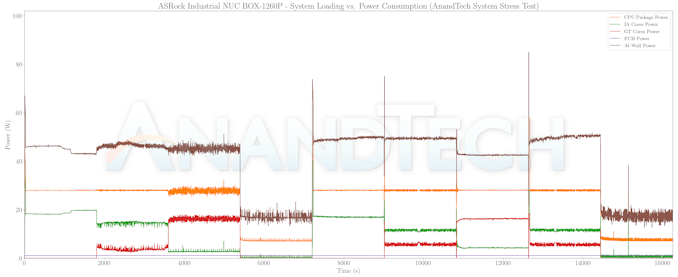
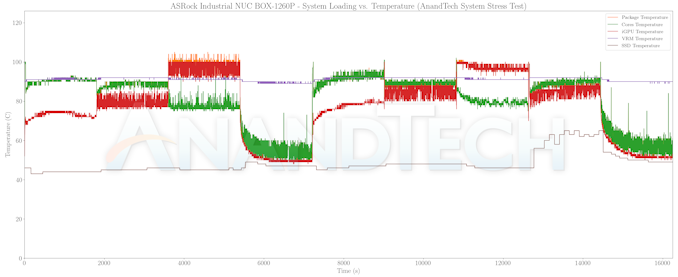
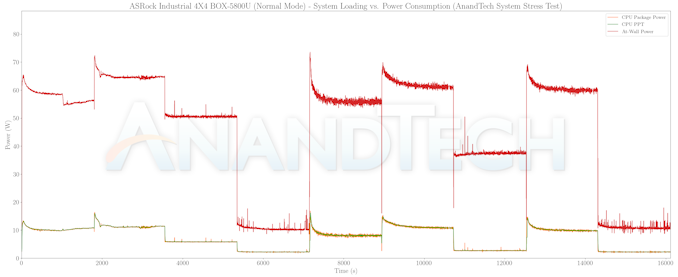
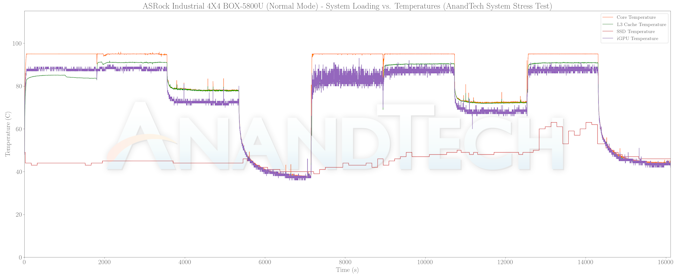
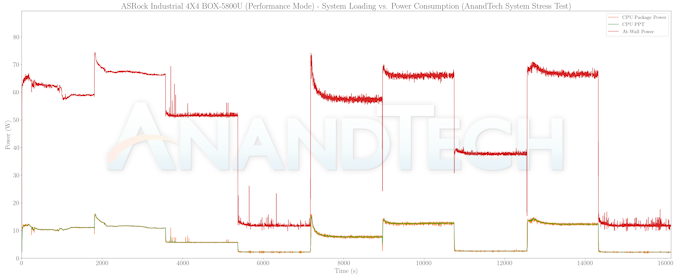
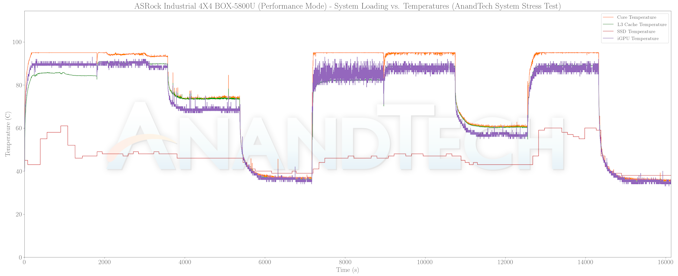








34 Comments
View All Comments
AdrianBc - Saturday, August 6, 2022 - link
Regarding the height of the case, there is no need to increase it. Intel has proved, already many years ago, that it is possible to cool without problems even a CPU with PL1 = 45 W, without increasing the volume over the classic high variant of NUC, i.e. with a volume under 0.7 L (as proven by the Skull Canyon NUC, which unfortunately did not have any successor, because Intel replaced it with much larger "NUC" computers intended for gaming).For better cooling in the same case, it would be enough to remove the possibility of installing a 2.5" HDD/SDD, while keeping the same size for the case.
The freed height could be used for a taller cooler, with enough capacity to cool even a 45 W CPU, not only a 28 W CPU.
AdrianBc - Saturday, August 6, 2022 - link
I want to add that even in the coolers of the same height the quality can vary a lot, presumably depending on price.I have a couple of the "8th generation" NUCs, and those had much better coolers than all the older NUCs that I have used, but also, from what I have heard or read, much better than the coolers of newer NUCs, which presumably have reverted to some cheaper coolers.
Those NUC8 coolers, not only are completely silent in normal use, but at maximum load on a Coffee Lake U i7 CPU with PL1 = 30 W and PL2 = 50 W, i.e. with a PL1 default value that is higher than the 28 W nominal value, there is absolutely no thermal throttling regardless how long the computer works at the maximum power consumption of 30 W and the junction temperature never exceeds 90 Celsius degrees.
So a more expensive cooler might also provide an improvement even when it is not taller.
plonk420 - Thursday, August 18, 2022 - link
3dprint one?AdrianBc - Saturday, August 6, 2022 - link
For some reason, the Thunderbolt connector has not been certified yet.Because of that, it cannot be advertised yet.
However, I have seen multiple reports that it works without problems, including in this article.
fishingbait15 - Friday, August 5, 2022 - link
So wish we could get these things running ChromeOS. I wonder if ChromeOS Flex would at least allow the Linux crosvm to run ...PeachNCream - Sunday, August 7, 2022 - link
Thinking that would be good also. What about Android x86 as an alternative? Both should still be well embedded in Alphabet's ecosystem and feature the end user monitoring, data collection, and commercialization recommendations that Google is so good at in terms of how it partners with advertisers to get you relevant, interesting ad content.You could also probably install Linux on bare metal if all you want is vanilla Linux though you aren't going to benefit from having your compute activities observed for better product placement that you would with Google distros of Linux.
iranterres - Friday, August 5, 2022 - link
Nice to see the core i6 in the benchmarks.MrCommunistGen - Friday, August 5, 2022 - link
I'd really love to see HDMI 2.1 ports on these machines since both AMD and Intel platforms should theoretically be able to support the newer standard from their iGPUs.If either supported HDMI 2.1 I'd consider using one as a multimedia box hooked up to a TV.
nandnandnand - Friday, August 5, 2022 - link
https://www.cnx-software.com/2022/01/05/intel-alde...https://www.theverge.com/2022/1/4/22855915/intel-1...
Intel only integrated HDMI 2.0b support. I guess another chip has to be added to get HDMI 2.1, like in this:
https://www.tweaktown.com/news/85259/gigabyte-brix...
Rembrandt supports HDMI 2.1, as will the iGPU in Raphael. Raptor Lake will add it according to this leaked slide:
https://www.notebookcheck.net/Intel-Raptor-Lake-S-...
So it will become more common to see HDMI 2.1 support in 2023-2024. DisplayPort 2.0 as well.
Igor_Kavinski - Saturday, August 6, 2022 - link
Excellent review, Ganesh! Really enjoyed seeing the battle between these two CPUs. Some of the wins for the Intel Alder Lake were surprising, like the iGPU and in some benchmarks like 7-zip, 5800U is a monster! Hope to see more "reviews done right" from you soon!